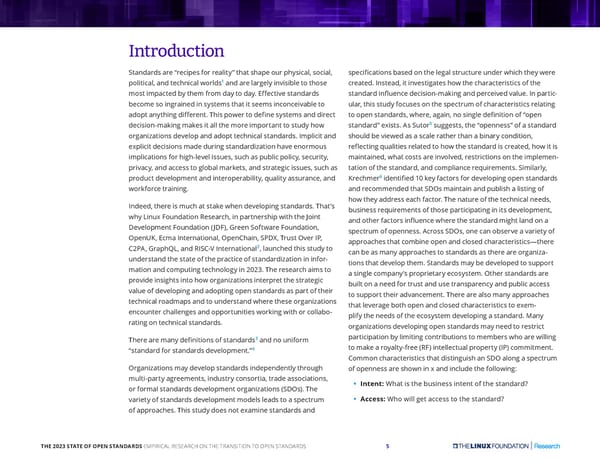Introduction Standards are “recipes for reality” that shape our physical, social, specifications based on the legal structure under which they were 1 political, and technical worlds and are largely invisible to those created. Instead, it investigates how the characteristics of the most impacted by them from day to day. Effective standards standard influence decision-making and perceived value. In partic- become so ingrained in systems that it seems inconceivable to ular, this study focuses on the spectrum of characteristics relating adopt anything different. This power to define systems and direct to open standards, where, again, no single definition of “open 5 decision-making makes it all the more important to study how standard” exists. As Sutor suggests, the “openness” of a standard organizations develop and adopt technical standards. Implicit and should be viewed as a scale rather than a binary condition, explicit decisions made during standardization have enormous reflecting qualities related to how the standard is created, how it is implications for high-level issues, such as public policy, security, maintained, what costs are involved, restrictions on the implemen- privacy, and access to global markets, and strategic issues, such as tation of the standard, and compliance requirements. Similarly, 6 product development and interoperability, quality assurance, and Krechmer identified 10 key factors for developing open standards workforce training. and recommended that SDOs maintain and publish a listing of how they address each factor. The nature of the technical needs, Indeed, there is much at stake when developing standards. That’s business requirements of those participating in its development, why Linux Foundation Research, in partnership with the Joint and other factors influence where the standard might land on a Development Foundation (JDF), Green Software Foundation, spectrum of openness. Across SDOs, one can observe a variety of OpenUK, Ecma International, OpenChain, SPDX, Trust Over IP, approaches that combine open and closed characteristics—there C2PA, GraphQL, and RISC-V International2, launched this study to can be as many approaches to standards as there are organiza- understand the state of the practice of standardization in infor- tions that develop them. Standards may be developed to support mation and computing technology in 2023. The research aims to a single company’s proprietary ecosystem. Other standards are provide insights into how organizations interpret the strategic built on a need for trust and use transparency and public access value of developing and adopting open standards as part of their to support their advancement. There are also many approaches technical roadmaps and to understand where these organizations that leverage both open and closed characteristics to exem- encounter challenges and opportunities working with or collabo- plify the needs of the ecosystem developing a standard. Many rating on technical standards. organizations developing open standards may need to restrict 3 participation by limiting contributions to members who are willing There are many definitions of standards and no uniform “standard for standards development.”4 to make a royalty-free (RF) intellectual property (IP) commitment. Common characteristics that distinguish an SDO along a spectrum Organizations may develop standards independently through of openness are shown in x and include the following: multi-party agreements, industry consortia, trade associations, • Intent: What is the business intent of the standard? or formal standards development organizations (SDOs). The variety of standards development models leads to a spectrum • Access: Who will get access to the standard? of approaches. This study does not examine standards and THE 2023 STATE OF OPEN STANDARDS EMPIRICAL RESEARCH ON THE TRANSITION TO OPEN STANDARDS 5
 The 2023 State of Open Standards Page 4 Page 6
The 2023 State of Open Standards Page 4 Page 6